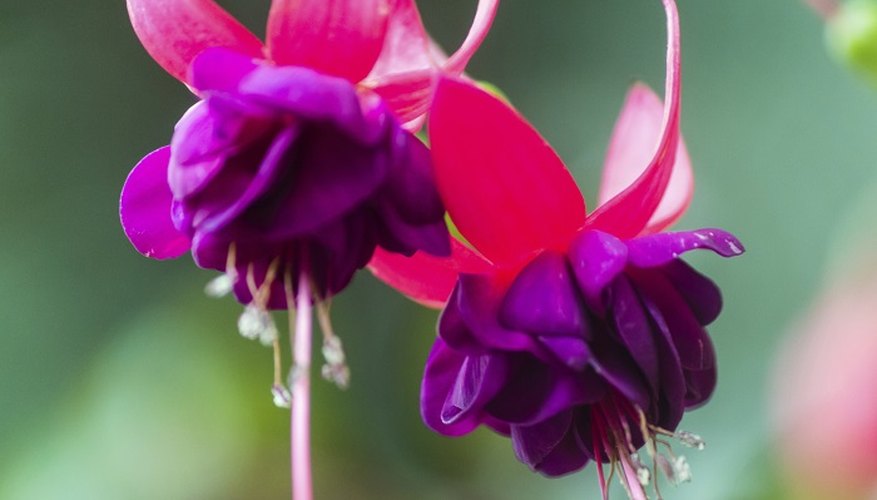Fuchsias are woody shrubs that produce neat, symmetrical foliage and hanging flowers in reds, purples, whites and pinks. These perennial plants live for many years and thrive in cool, moist conditions, with rich soil and frequent feedings. This lush growth and long lifespan lead to the plants outgrowing their sites and crowding neighbours, and may lead to depleted blooming and a leggy, woody appearance. Prune and divide your fuchsia at the proper time of year to produce new, healthy growth and a second plant.
- Fuchsias are woody shrubs that produce neat, symmetrical foliage and hanging flowers in reds, purples, whites and pinks.
- This lush growth and long lifespan lead to the plants outgrowing their sites and crowding neighbours, and may lead to depleted blooming and a leggy, woody appearance.
Divide fuchsias in late autumn or early spring, when the bush is dormant. This timing keeps the fuchsia from dying during the process. Divide fuchsias when they outgrow their space or their blooming becomes restricted.
Prepare a new spot for the second fuchsia. These plants do best with filtered, indirect or partial sun, cool temperatures, good air circulation and quick drainage. Give the new fuchsia 90 cm (3 feet) of space in the new site. Dig 10 cm (4 inches) of organic compost into the top 20 cm (8 inches) of soil in a 30 cm (1 foot) site. Fuchsias require quick, efficient drainage and good moisture retention, and they thrive in the nutrition of organic compost.
Prune the dormant fuchsia canes down to 60 cm (2 feet) to conserve energy and make the transplant easier. Dig the fuchsia's root ball up and brush or hose away soil to expose the root system.
- Prepare a new spot for the second fuchsia.
- Prune the dormant fuchsia canes down to 60 cm (2 feet) to conserve energy and make the transplant easier.
Trim off dead or broken roots, then cut the root system in two. Maintain two to three stems in each division, with an intact root system for each new plant. Put one division back in the established site.
Move the second division to the new site, and plant it in a hole as deep and wide as the root system. Fill amended soil in around the roots, and pack it down to secure the plant and eliminate air pockets, which could restrict root production.
- Trim off dead or broken roots, then cut the root system in two.
- Fill amended soil in around the roots, and pack it down to secure the plant and eliminate air pockets, which could restrict root production.
Give each fuchsia two large handfuls of bone meal to encourage rooting. Sprinkle the bone meal in a 30 cm (12 inch) circle around the base of each plant, then mix into the top 7.5 cm (3 inches). Supply each fuchsia with 2.25 litres (1/2 gallon) of water to settle the soil around the roots.
